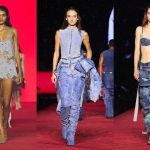It’s rare to go into a trend seminar these days without the mention of the globally turbulent times we are still living in. This was no different for FashionSnoops’ talk at the ongoing Copenhagen International Fashion Fair (CIFF) – taking place between August 9 and 11 – where the trend firm’s director of colour Joanne Thomas took to the stage to discuss what to expect for autumn/winter 24/25. And while it seems that the increased pressures fashion has been facing over recent years – whether it be economic, societal or political – have already had a profound impact on the industry and its performance, it seems that these pressures are expected to continue being endured for the upcoming season.
During her presentation, Thomas spoke on the need for designers to fit quotas that ultimately defined their values and stylistic choices for collections. However, she suggested that in place of simply viewing these constraints as barriers, brands should instead think within these constraints in order to adapt to the ever-changing consumer mindset. This idea was reflected in the three design aesthetics Thomas outlined to the attendees of CIFF.
Fragility: Soft armour and comfort-centric design
At the core of the first trend, ‘Fragility’, Thomas described an aesthetic of “fortified strength in the most delicate of times”. As consumers seek respite from the pressures of everyday life, Thomas suggested for brands to respond through the offering of a “soft armour”. Central qualities of this trend were that of embracing emotional intelligence through responsible business practices, the acceptance of solitude among consumers looking for escape and an increased dialogue surrounding mental health. Particular clothing categories that addressed these concerns lay in comfort-centric styles, such as loungewear and sleepwear, while Thomas also highlighted the need to consider services that provide multi-layer health benefits.
Colours linked to ‘fragility’ were described to bring a harmonious balance between the combination of strength and subtly, with Thomas further referencing a “captivating visual push and pull” seen in the incorporation of nude tones alongside warmer hues. These could also be viewed in the underlying themes for both womens- and menswear, the former of which put more emphasis on the idea of “divine femininity”, shown through the use of “preserved florals” and the ease and comfort of materials. Meanwhile, for menswear, such a trend was present through a similar take on “effortless grace” that is both cool and contemporary with a timeless aesthetic.
Immersive: Playing on protective pieces and reacting to your surroundings
When speaking on ‘Immersive’, Thomas touched on a “new state of existence” that went beyond the ordinary and brought together the contrast of functionality and fantasy. Here, Thomas looked outside of our reality on earth and towards otherworldly perspectives, cosmic themes and highly personalised methods to achieve an evolution of self-expression. The result is the use of updated materials that offer metallic sheens, exaggerated surfaces and fully customisable looks, either offering a gateway into personal experimentation or playing on the concept of protection. Thomas also looked into the idea of tech as a mode to explore immersion, noting that brands need to particularly pay attention to materials that are reactive to their environment.
The colour palette for this theme is defined by hyper bright hues selected for their ability to ignite the senses. The visually dynamic curation captures a sense of warmth, while also drawing inspiration from nature, a quality that was imperative to womenswear, where the design aesthetic was linked with the growth of plants. Evidence of such a process could be seen in a modular wardrobe, which adapts to the wearer’s needs and equips them for any situation. A similar thing could be said for the men’s wardrobe, however, in contrast, Thomas focused more on personalised utility as a central pillar, as well as the mixing of futurism and traditionalism that presented a progressive yet hesitant version of tomorrow.
Sentimental: The Wes Anderson effect
In another take on responding to the turbulent period we are passing through, ‘Sentimental’ views the concept of nostalgia as a safe space for life’s uncertainties. Here, consumers will welcome a contextualisation of history, Thomas noted, as well as the longing for an intimate connection to creations that fall under this banner. “Cinematic charm” and “immersive storytelling” were phrases touched on for this trend, and can already be seen in the increased popularity of film director Wes Anderson, who is known for his distinct filmography style. Thomas further commented on circular processes that will drive this trend, such as the repair culture and DIY elements, each pushing a desire for crafts and catering to the emotional engagement customers are seeking.
Colours for this theme further emphasise the handmade, artsy feel of this aesthetic, with warm tones bringing drama while contrasting cooler hues complete the cinematic perspective Thomas highlights. For both men and women, ‘Sentimental’ is formulated around heritage and traditionalism as a source of comfort and familiarity. For women specifically, the theme revolves around functional elements of classic silhouettes. Meanwhile, for men, it is translated into a more figurative take, which Thomas described as an “imaginative twist on farm living” through “rugged yet dreamy workwear”. Think brocade blazers and crafted overcoats.



